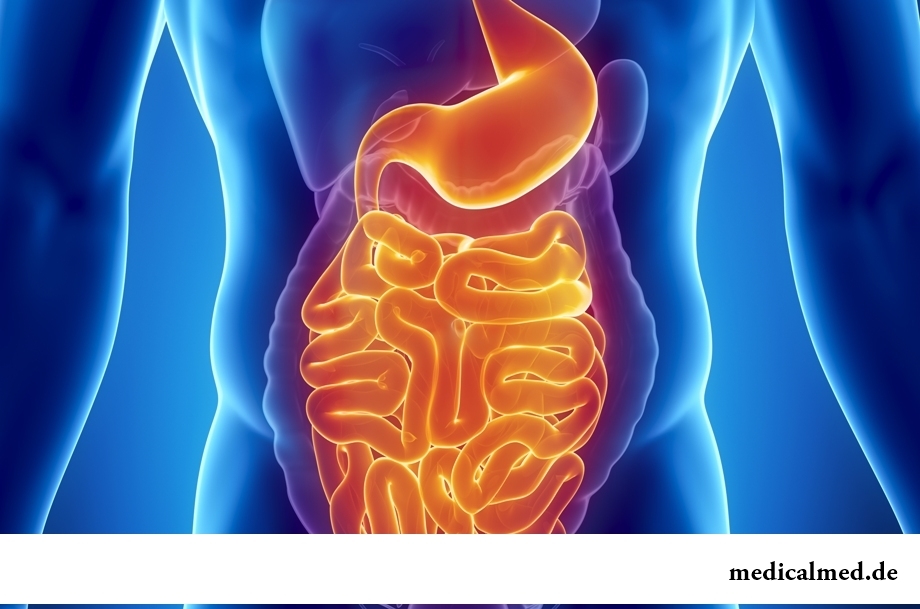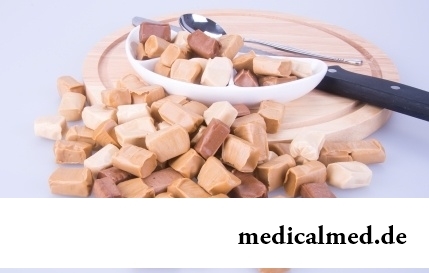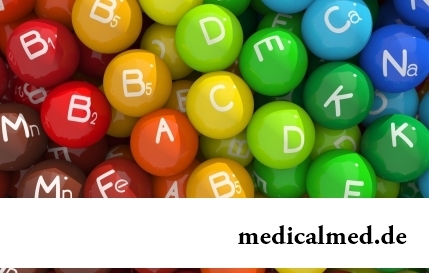





Small bowel
The small bowel is located between a stomach and a caecum and represents the biggest department of the alimentary system on the extent. The main function of a small bowel is chemical treatment of a food lump (chyme) and absorption of products of its digestion.

Structure
The small bowel represents very long (from 2 to 5 m) a hollow tube. It begins from a stomach, and comes to an end in an ileocecal corner, in the place of its connection with a caecum. Anatomically the small bowel is conditionally subdivided into three departments:
1. Duodenum. She is located in a back part of an abdominal cavity and in the form reminds a letter "C".;
2. Jejunum. It is located in a middle part of an abdominal cavity. Its loops lie very freely, are covered with a peritoneum from all directions. This gut received the name because when opening corpses pathologists practically always find it empty;
3. The ileal gut – is in the lower part of an abdominal cavity. It differs from other departments of a small intestine in thicker walls, the best blood supply and big diameter.
Digestion in a small bowel
Food weight passes on a small bowel approximately in four hours. During this time the nutrients which are contained in food continue to be split by enzymes of intestinal juice on smaller components. Digestion in a small bowel consists as well in active nutritive absorption. In her cavity the mucous membrane forms numerous outgrowths and fibers that significantly increases the area of the soaking-up surface. So at adults the area of a small intestine makes not less than 16,5 square meters.
Functions of a small bowel
As well as any other body in a human body the small bowel carries out not one, and several functions. Let's consider them in more detail:
- Secretory function of a small bowel – consists in development by cells of her mucous membrane of the intestinal juice containing such enzymes as an alkaline phosphatase, disaccharidase, a lipase, cathepsines, peptidase. All of them decompose the nutrients which are contained in a chyme to simpler (proteins on amino acids, fats on water and fatty acids, and carbohydrates on monosaccharides). In days at the adult about two liters of intestinal juice cosecrete. It contains a large amount of slime which protects walls of a small intestine from self-digestion;
- Digestive function. Digestion in a small bowel consists in splitting of nutrients and in their further absorption. Thanks to it only unavailable and indigestible products get into a large intestine.
- Endocrine function. In walls of a small intestine there are special cells producing peptide hormones which not only regulate function of intestines but also exert impact and on other internals of a human body. Most of all similar cells it is located in a duodenum;
- Motor function. At the expense of longitudinal and ring muscles there are wavy reductions of walls of a small bowel pushing a chyme forward.
Diseases of a small bowel
All diseases of a small bowel have similar symptoms and ponosam are shown by abdominal pains, a meteorism, rumbling. The chair happens several times a day, plentiful, to the remains of undigested food and a large amount of slime. Blood in it is observed extremely seldom.
Among diseases of a small bowel its inflammation – enteritis which can be acute or chronic is most often observed. Acute enteritis usually is caused by pathogenic microflora and at full treatment within several days comes to an end with an absolute recovery. At it is long the proceeding chronic enteritis with frequent aggravations at patients also the abenteric symptoms of a disease caused by disturbance of the soaking-up function of a small intestine develop. They complain of weight loss and the general weakness, quite often they have an anemia. The vitamin deficiency of group B and folic acid leads to emergence of cracks in corners of a mouth (perleche), stomatitis, a glossitis. Insufficient receipt in an organism of vitamin A is an origin of dryness of a cornea and disturbance of twilight sight. Disturbances of absorption of calcium can become the reason of development of osteoporosis and the pathological changes arising on its background.
Rupture of a small bowel
Among all abdominal organs the small bowel is most of all subject to traumatic damages. It is explained by vulnerability and considerable length of this site of intestines. The isolated rupture of a small bowel is observed in no more than in 20% of cases, and to a thicket it is combined also with other traumatic injuries of abdominal organs.
The most frequent mechanism of traumatic injury of a small intestine is direct and rather strong blow in the stomach leading to pressing of loops of intestines to pelvic bones or a backbone and damage of their walls.
At a rupture of a small bowel more than a half of victims has a depressed case and considerable internal bleeding.
The only method of treatment of a rupture of a small bowel is the surgery which is carried out in the emergency order. During an operative measure make a stop of bleeding (hemostasis), eliminate a source in an abdominal cavity of intestinal contents, recover normal passability of intestines and carefully sanify an abdominal cavity.
The earlier from the moment of an injury of a small bowel operation is carried out, the it is more than chances of recovery of the victim.
The liver is the heaviest body in our body. Its average weight makes 1,5 kg.

Practice of hypnotic impact on consciousness of the person contains about two millennia. During this time scientists were in time a lot of things узн...
Section: Articles about health
The mankind knows that some toxins at intake in the minimum quantities have therapeutic effect from an extreme antiquity. Many substances recognized poisonous are applied in the medical purposes also today, being the main deystvuyushch...
Section: Articles about health
Aging — natural and inevitable process. Over time our skin loses elasticity, on it saggings are formed, the face form loses former clearness. The procedure of nitevy lifting (nitevy tightening) can successfully solve this problem. In order that it is better to get acquainted with this popular procedure, we will tell you 6 cognitive facts about it....
Section: Articles about health
When overcomes feeling of hunger, and an opportunity to have dinner fully is absent, having a snack − small on volume comes to the rescue...
Section: Articles about health
The way of life of people promptly changes from year to year: if about ten years ago the personal computer was not in each family, then today already very few people do without this device. Certainly, and children master the computer at full speed: they not only I play...
Section: Articles about health
Childbirth is the most important event in life of each woman. We are women we give birth to the new little man on this light. Now the tendency to that was outlined, as men want to participate in labor too. But there is a question and whether it is worth allowing the husbands on childbirth?...
Section: Articles about health
Neurosis is called pathology of a nervous system at which deviations in functioning of the highest nervous processes are observed. Nye...
Section: Articles about health
All of us, unfortunately, should face flu nearly an every year. It would seem, so frequent disease has to be studied already up and down, and each person, at least once by it had (and the number of such people in our country aims at 100%), a dolzha...
Section: Articles about health
No, probably, the person who would not have cold. Cold, cough, a headache – these symptoms are known to everyone. The peak of catarrhal diseases is the share of fall. SARS already came to schools and kindergartens, flu slowly makes the way to the cities, in a word, winter close!...
Section: Articles about health
Food with the increased content of sugar is attractive to most of people - it is scientifically confirmed fact. Business here not in a nevozder...
Section: Articles about health
The majority of gynecologic diseases prove three main signs, each of which speaks about need of a visit to the gynecologist. Certainly, it is possible to establish the exact diagnosis only after inspection, but on the basis of some signs it is possible пр...
Section: Articles about health
Milk and products of its processing by right occupy one of the main places in a diet of the modern person. They contain proteins, necessary for normal life activity, fats, vitamins and microelements, and are an important part of various medical diets....
Section: Articles about health
For many spouses the question of planning of a family is one of the main. The choice problem effect at the same time comes out on top...
Section: Articles about health
Contrary to popular belief, the multiple sclerosis (MS) is not connected neither with sclerous changes of walls of vessels, nor with age forgetfulness and problems with concentration of attention. This disease has the autoimmune nature. Pathological process of a vyrazh...
Section: Articles about health
The depression not without reason is considered one their main troubles of our century: for scientific and technical progress, acceleration of rate of life and a surplus of information of people it is forced to pay with stresses, negative emotions and weakening of protective forces of an organism. As a result widely the states which are characterized by the increased uneasiness, falling of interest in life, spiritual and physical discomfort extend....
Section: Articles about health
Not everyone can brag of the shining Hollywood smile. Even at the person who is regularly visiting the stomatologist and watching з...
Section: Articles about health
Proofs of efficiency of Mildronate at treatment of coronary heart disease with stenocardia can be found in many publications of the end of the twentieth century. Researches were conducted since 1984, including placebo - controlled effects. In total клиничес...
Section: Articles about health
Antibiotics - - it is possible to call the chemical compounds suppressing growth of bacteria the break in the field of medicine which allowed to save mankind from many diseases incurable earlier: tuberculosis, plague, syphilis and many others. The contribution of drugs to rescue of people from epidemics of dangerous infections is huge, however at careless use antibiotics are capable to cause to an organism serious damage. Negative action can be shown in the form of easing of immunity, disturbance of balance of microflora in кишеч...
Section: Articles about health
80% of women at least once to lives complained of discomfortable feelings to breasts, consolidations and nagrubaniye. These are mastopathy symptoms. Mas...
Section: Articles about health
Not without reason doctors say that 90% of diseases begin or develop because of misoperation of intestines. Disturbance of its functions is connected with various factors among which the important place belongs to excessive "clutter" of an intestinal path. In an organism скаплив...
Section: Articles about health
Season of activity of viral infections in the heat. Everyone can get sick, but probability of this unpleasant event it is possible and it is necessary to minimize. There is a number of rules, following to which will help or to avoid absolutely infection with flu or a SARS, or to have an illness benign and without essential complications. About ways of prevention of seasonal infections the speech in this article will also go....
Section: Articles about health
Musicotherapy – a treatment method which caused and causes a set of a controversy concerning its efficiency. However the facts are relentless:...
Section: Articles about health
During foot walks blood moves on vessels more actively and one and all bodies are supplied with a large amount of oxygen. It affects the state of health of the person very positively....
Section: Slideshow
Color of plants is caused by presence at them of certain chemical compounds. Let's talk about what is meant by various colors of vegetables and fruit and what properties they give them....
Section: Articles about health
The trophic ulcer is not an independent disease. This heavy complication arising owing to a thermal injury (a burn...
Section: Articles about health
Quite large number of people adheres to the principles of vegetarian food. But how to be if in a family of vegetarians there are children? Whether it is possible to eat also it the same as to parents, or after all the children's organism is not adapted for the use only раст...
Section: Articles about health
Vitamin complexes belong to the most popular drugs, probably, in our country there is no person who was not hearing about advantage of vitamins and never their accepting. The more vitamins, the better, we consider and as it appeared, cruelly we are mistaken. Whether vitamins, whether so harmlessly general hobby for polyvitaminic complexes and whether it is possible to do without them are so useful? Let's try to understand....
Section: Articles about health
